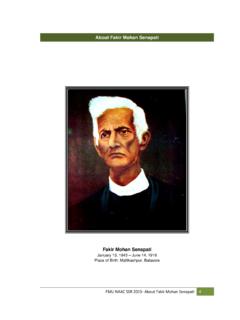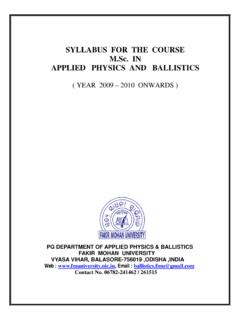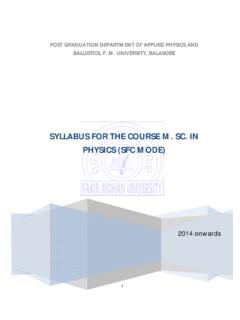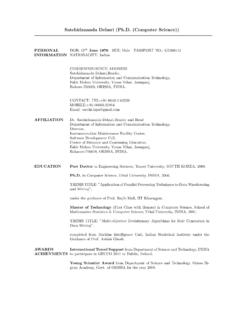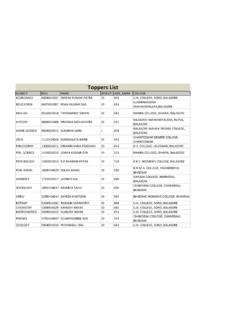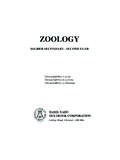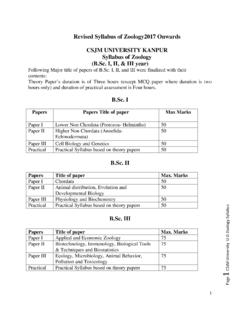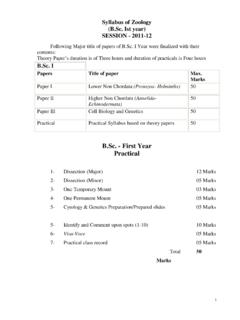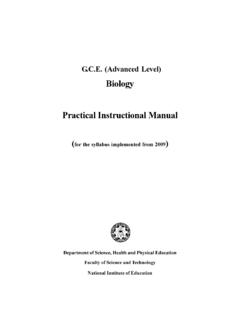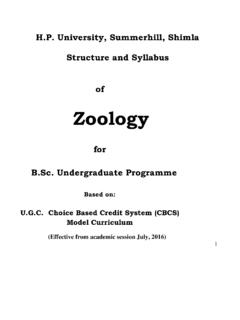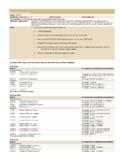Transcription of CORE COURSE SEMESTER - 1 ZOOLOGY ( HONS ) …
1 CORE COURSE SEMESTER - 1 ZOOLOGY ( HONS ). ZOO. CC I (Th) : DIVERSITY AND EVOLUTION OF NON- chordata . ( protista TO pseudocoelomates ). Time 3hrs : 100 [60(End sem)+15(Int)+25(Pr)] Credit- 6 [ 4(TH) +2(PR) ]. Unit 1: Phylum Protozoa, Parazoa and Metazoa General characteristics and classification up to classes; Life cycle, pathogenicity and prophylaxis of Plasmodium vivax, Trypanosomagambiense and Entamoebaistolytica;. Locomotion and reproduction in Protozoa; Evolution of Parazoa and Metazoa. Unit 2: Phylum Porifera and Ctenophora General characteristics and classification up to classes; Canal system in sponges.
2 General characteristics and evolutionary significance. Unit 3: Phylum Cnidaria General characteristics and classification up to classes; Metagenesis in Obelia;. Polymorphism in Cnidaria; Corals and coral reefs. Unit 4: Phylum Platyhelminthes General characteristics and classification up to classes; Life cycle, pathogenicity and prophylaxis of Fasciola hepatica and Taeniasolium; Parasitic adaptations. Unit 5 :Phylum Nemathelminthes General characteristics and classification up to classes; Life cycle, pathogenicity and prophylaxis of Ascarislumbricoides and Wuchereriabancrofti; Parasitic adaptations.
3 Th Note: Classification to be followed from Barnes RD (1982)Invertebrate ZOOLOGY . 5 Edition.. ( LAB )PRACTICALS Marks 25. Phylum Protozoa 1. Morphology of Paramecium, Binary fission and Conjugation in Paramecium. 2. Life stages of Plasmodium vivax, Trypanosmagambiense and Entamoebahistolytica (Slides/ Micro- photographs). 3. Examination of pond water for protists. Phylum Porifera 4. Study of Sycon (including and ), Hyalonema, and Euplectella. 5. Temporary mounts of spicules, gemmules and spongin fibres. Phylum Cnidaria 6. Study of Obelia, Physalia, Millepora, Aurelia,Ephyra larva, Tubipora, Corallium,Alcyonium, GorgoniaandMetridium(including and ).
4 Phylum Ctenophora 7. Any one specimen/slide. Phylum Platyhelminthes 8. Study of adult Fasciola hepatica, Taeniasolium and their life stages (Slides/. microphotographs). Phylum Nemathelminthes 9. Study of adult Ascarislumbricoides, Wuchereriabancrofti and their life stages (Slides/ microphotographs). th Note: Classification to be followed from Barnes RD (1982)Invertebrate ZOOLOGY . 5 Edition.. SUGGESTED READINGS. st 1. Arora MP (2006) Non- chordata -I. 1 edition. st Himalaya Publishing House, New Delhi. 2. Arora MP (2008) Non- chordata -II.
5 1 edition. Himalaya Publishing House, New Delhi. th 3. Barnes RD (1982) Invertebrate ZOOLOGY . 6 Edition. Holt Saunders International Edition. 4. Barnes RSK, CalowrdP, Olive PJW, Golding DW & Spicer JI (2002) The Invertebrates: A New Synthesis. 3 Edition. Blackwell Science, USA. nd 5. Barrington EJW (1979) Invertebrate Structure and Functions. 2 Edition. ELBS. and Nelson. 6. Boradale LA and Potts EA (1961) Invertebrates: A Manual for the use of Students. Asia Publishing Home. 7. Jordan EL and Verma PS (1963) Invertebrate ZOOLOGY . Revised Edition.
6 S. Chand, New Delhi. CORE COURSE SEMESTER - 1 ZOOLOGY ( HONS ). ZOO- CC- II (Th) - PERSPECTIVES IN ECOLOGY (CREDITS: THEORY-4, PRACTICALS-2). Time 3hrs : 100 [60(End sem)+15(Int)+25(Pr)] Credit- 6 [ 4(TH) +2(PR) ]. Unit 1: Introduction to Ecology Relevance of studying ecology; History of ecology; Autecology and synecology;. Levels of organization; Laws of limiting factors; Detailed study of temperature and light as physical factors. Unit 2: Population Unitary and modular populations; Unique and group attributes of population: Density, natality, mortality, life tables, fecundity tables, survivorship curves, age ratio, sex ratio, dispersal and dispersion; Exponential and logistic growth, equation and patterns, r and K strategies, Population regulation - density-dependent and independent factors.
7 Population interactions, Gause's Principle with laboratory and field examples; Lotka- Volterra equation for competition and Predation, functional and numerical responses. Unit 3: Community Community characteristics: dominance, diversity, species richness, abundance, stratification; Ecotone and edge effect; Ecosystem development (succession) with example and Theories pertaining to climax community. Unit 4: Ecosystem Types of ecosystem; Food chain, Detritus and grazing food chains, Linear and Y- shaped food chains; Food web; Energy flow through the ecosystem; Ecological pyramids and Ecological efficiencies; Nutrient and biogeochemical cycle, Nitrogen cycle and Sulphur cycle.
8 Unit 5;Conservation of Biodiversity Types of biodiversity, its significance, loss of biodiversity; Conservation strategies (in situ and ex situ); Role of ZSI, WWF, IUCN; Wildlife (Protection) Act, 1972. ( LAB ) PRACTICALS Marks 25. 1. Study of life tables and plot 2. ing of survivorship curves of different types from the hypothetical/real data provided. 3. Determination of population density in a natural/hypothetical community by quadrate method and calculation of Shannon-Weiner diversity index for the same community. of an aquatic ecosystem: fauna and flora Measurement of area, temperature,turbidity/penetration of light, determination of pH, and Dissolved Oxygen content(Winkler's method), Chemical Oxygen Demand and free CO2.
9 On a visit to National Park/Biodiversity Park/Wildlife sanctuary. SUGGESTED READINGS. 1. Colinvaux PA (1993) Ecology. II Edition. John Wiley and Sons, Inc., USA. 2. Dash MC (1993) Fundamentals of Ecology. McGraw Hill Book Company, New Delhi. st 3. Joshi N and Joshi PC (2012) Ecology and Environment. 1 Edition. Himalaya Publishing House, New Delhi. 4. Odum EP (2008) Fundamentals of Ecology. Indian Edition. Brooks/Cole. th 5. Ricklefs, , (2000). Ecology. 5 Edition. Chiron Press. 6. Robert Leo Smith Ecology and field biology Harper and Row.
10 7. Singh JS, Gupta SR and Singh SP (2014) Ecology, Environmental Science and Conservation. S. Chand, New Delhi. CORE COURSE SEMESTER 1I ZOOLOGY ( HONS ). ZOO. CC III (Th) : DIVERSITY AND EVOLUTION OF NON- chordata . (COELOMATE NONCHORDATES). Time 3hrs : 100 [60(End sem)+15(Int)+25(Pr)] Credit- 6 [ 4(TH) +2(PR). ]. Unit 1: Phylum Annelida General characteristics and classification up to classes; Evolution of Coelom;. Metamerism and Excretion in Annelida. Unit 2: Phylum Arthropoda General characteristics and classification up to classes; Vision in Arthropoda.
